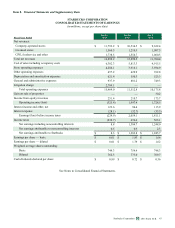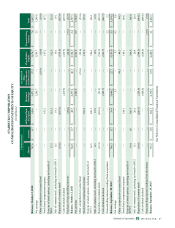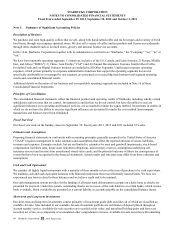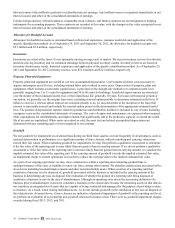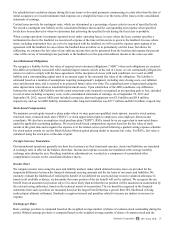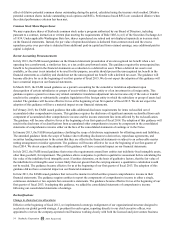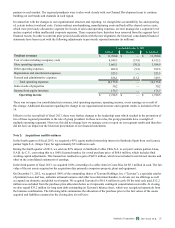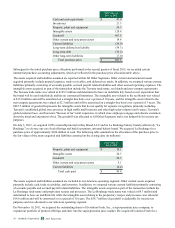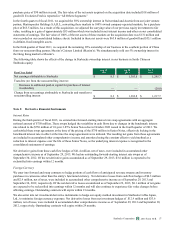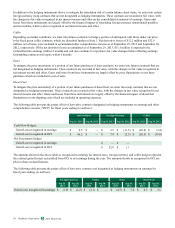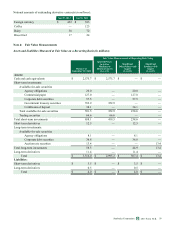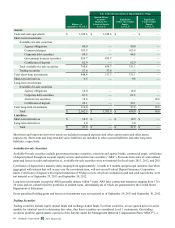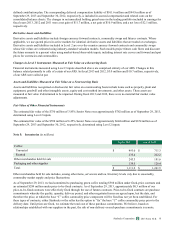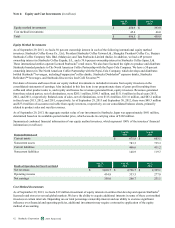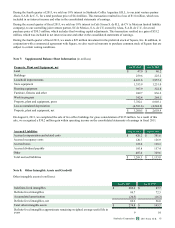Starbucks 2013 Annual Report Download - page 61
Download and view the complete annual report
Please find page 61 of the 2013 Starbucks annual report below. You can navigate through the pages in the report by either clicking on the pages listed below, or by using the keyword search tool below to find specific information within the annual report.
53
For scheduled rent escalation clauses during the lease terms or for rental payments commencing at a date other than the date of
initial occupancy, we record minimum rental expenses on a straight-line basis over the terms of the leases on the consolidated
statements of earnings.
Certain leases provide for contingent rents, which are determined as a percentage of gross sales in excess of specified levels.
We record a contingent rent liability on the consolidated balance sheets and the corresponding rent expense when specified
levels have been achieved or when we determine that achieving the specified levels during the fiscal year is probable.
When ceasing operations in company-operated stores under operating leases, in cases where the lease contract specifies a
termination fee due to the landlord, we record such expense at the time written notice is given to the landlord. In cases where
terms, including termination fees, are yet to be negotiated with the landlord, we will record the expense upon signing of an
agreement with the landlord. In cases where the landlord does not allow us to prematurely exit the lease, but allows for
subleasing, we estimate the fair value of any sublease income that can be generated from the location and expense the present
value of the excess of remaining lease payments to the landlord over the projected sublease income at the cease-use date.
Asset Retirement Obligations
We recognize a liability for the fair value of required asset retirement obligations (“ARO”) when such obligations are incurred.
Our AROs are primarily associated with leasehold improvements, which, at the end of a lease, we are contractually obligated to
remove in order to comply with the lease agreement. At the inception of a lease with such conditions, we record an ARO
liability and a corresponding capital asset in an amount equal to the estimated fair value of the obligation. The liability is
estimated based on a number of assumptions requiring management’s judgment, including store closing costs, cost inflation
rates and discount rates, and is accreted to its projected future value over time. The capitalized asset is depreciated using the
same depreciation convention as leasehold improvement assets. Upon satisfaction of the ARO conditions, any difference
between the recorded ARO liability and the actual retirement costs incurred is recognized as an operating gain or loss, included
in cost of sales including occupancy costs, in the consolidated statements of earnings. As of September 29, 2013 and
September 30, 2012, our net ARO asset included in property, plant and equipment was $3.8 million and $8.8 million,
respectively, and our net ARO liability included in other long-term liabilities was $27.7 million and $42.6 million, respectively.
Stock-based Compensation
We maintain several equity incentive plans under which we may grant non-qualified stock options, incentive stock options,
restricted stock, restricted stock units (“RSUs”) or stock appreciation rights to employees, non-employee directors and
consultants. We also have an employee stock purchase plan (“ESPP”). RSUs issued by us are equivalent to nonvested shares
under the applicable accounting guidance. We record stock-based compensation expense based on the fair value of stock
awards at the grant date and recognize the expense over the related service period following a graded vesting expense schedule.
For stock option awards we use the Black-Scholes-Merton option pricing model to measure fair value. For RSUs, fair value is
calculated using the stock price at the date of grant.
Foreign Currency Translation
Our international operations generally use their local currency as their functional currency. Assets and liabilities are translated
at exchange rates in effect at the balance sheet date. Income and expense accounts are translated at the average monthly
exchange rates during the year. Resulting translation adjustments are recorded as a component of accumulated other
comprehensive income on the consolidated balance sheets.
Income Taxes
We compute income taxes using the asset and liability method, under which deferred income taxes are provided for the
temporary differences between the financial statement carrying amounts and the tax basis of our assets and liabilities. We
routinely evaluate the likelihood of realizing the benefit of our deferred tax assets and may record a valuation allowance if,
based on all available evidence, we determine that some portion of the tax benefit will not be realized. We recognize the tax
benefit from an uncertain tax position only if it is more likely than not that the tax position will be sustained on examination by
the relevant taxing authorities, based on the technical merits of our position. The tax benefits recognized in the financial
statements from such a position are measured based on the largest benefit that has a greater than 50% likelihood of being
realized upon ultimate settlement. Starbucks recognizes interest and penalties related to income tax matters in income tax
expense.
Earnings per Share
Basic earnings per share is computed based on the weighted average number of shares of common stock outstanding during the
period. Diluted earnings per share is computed based on the weighted average number of shares of common stock and the
2013 10-K
Starbucks Corporation Form


